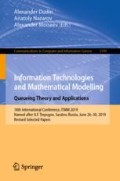Abstract
Methods of queueing theory are often used for telecommunication systems performance evaluation. According to this approach, all MAC and PHY layer protocols details are modelled with a given service time distribution, and the precision of the estimated properties depends on this distribution function selection. While for Ethernet and wireless relay networks the service time is roughly equal to the sum of packet and headers sizes divided by the channel bitrate, it is not so easy to estimate the service time for wireless networks channels based on CSMA/CA including IEEE 802.11 (WiFi) and IEEE 802.15.4 (ZigBee) due to random exponential backoff and collisions. In this paper we use a simple model of the saturated channel described as a semi-Markov random absorbing process, which is based on Bianchi model [2]. We use this process to find a service time phase-type (PH) distribution matching the first two moments of the semi-Markov process. We also use channel simulation model to sample transmission delays in unsaturated mode and find another PH-distribution using G-FIT [12] algorithm. Then we use these PH-distributions to estimate end-to-end delays, queue sizes and nodes utilization in a multi-hop wireless network with linear topology using \(M/PH/1/N \rightarrow \bullet /PH/1/N \bullet \dots \bullet /PH/1/N\) queueing network. All results are compared to wireless network simulation model, and demonstrate the cases in which the queueing network tends to provide results close to real network performance.
This work was partly financially supported by the Russian Foundation for Basic Research, grant No. 18-57-00002.
Access this chapter
Tax calculation will be finalised at checkout
Purchases are for personal use only
Notes
- 1.
Experiment source code: https://github.com/larioandr/2019-itmm-paper-model.
References
Banchs, A., Serrano, P., Azcorra, A.: End-to-end delay analysis and admission control in 802.11 DCF WLANs. Comput. Commun. 29(7), 842–854 (2006)
Bianchi, G.: Performance analysis of the IEEE 802.11 distributed coordination function. IEEE J. Sel. Areas Commun. 18(3), 535–547 (2000)
Chatzimisios, P., Vitsas, V., Boucouvalas, A.: Throughput and delay analysis of IEEE 802.11 protocol. In: Proceedings 3rd IEEE International Workshop on System-on-Chip for Real-Time Applications, pp. 168–174. IEEE (2002)
Dai, L., Sun, X.: A unified analysis of IEEE 802.11 DCF networks: stability, throughput, and delay. IEEE Trans. Mob. Comput. 12(8), 1558–1572 (2013)
Dong, L.F., Shu, Y.T., Chen, H.M., Ma, M.D.: Packet delay analysis on IEEE 802.11 DCF under finite load traffic in multi-hop ad hoc networks. Sci. China Ser. F Inf. Sci. 51(4), 408–416 (2008)
Felemban, E., Ekici, E.: Single hop IEEE 802.11 DCF analysis revisited: accurate modeling of channel access delay and throughput for saturated and unsaturated traffic cases. IEEE Trans. Wirel. Commun. 10(10), 3256–3266 (2011)
Haghani, E., Krishnan, M.N., Zakhor, A.: A method for estimating access delay distribution in IEEE 802.11 networks. In: 2011 IEEE Global Telecommunications Conference - GLOBECOM 2011, pp. 1–6. IEEE (December 2011)
Hung, F.Y., Marsic, I.: Access delay analysis of IEEE 802.11 DCF in the presence of hidden stations. In: IEEE GLOBECOM 2007–2007 IEEE Global Telecommunications Conference, pp. 2541–2545. IEEE (November 2007)
Issariyakul, T., Niyato, D., Hossain, E., Alfa, A.: Exact distribution of access delay in IEEE 802.11 DCF MAC. In: GLOBECOM 2005. IEEE Global Telecommunications Conference, 2005, p. 5. IEEE (2005). pp.-2538
Lauwens, B., Scheers, B., Van de Capelle, A.: Performance analysis of unslotted CSMA/CA in wireless networks. Telecommun. Syst. 44(1–2), 109–123 (2010)
Sakurai, T., Vu, H.: MAC access delay of IEEE 802.11 DCF. IEEE Trans. Wirel. Commun. 6(5), 1702–1710 (2007)
Thummler, A., Buchholz, P., Telek, M.: A novel approach for fitting probability distributions to real trace data with the EM algorithm. In: 2005 International Conference on Dependable Systems and Networks (DSN 2005), pp. 712–721. IEEE (2005)
Tickoo, O., Sikdar, B.: Modeling queueing and channel access delay in unsaturated IEEE 802.11 random access MAC based wireless networks. IEEE/ACM Trans. Netw. 16(4), 878–891 (2008)
Vardakas, J., Papapanagiotou, I., Logothetis, M., Kotsopoulos, S.: On the end-to-end delay analysis of the IEEE 802.11 distributed coordination function. In: Second International Conference on Internet Monitoring and Protection (ICIMP 2007), pp. 16–16. IEEE (July 2007)
Vishnevsky, V., Dudin, A., Kozyrev, D., Larionov, A.: Methods of performance evaluation of broadband wireless networks along the long transport routes. In: Vishnevsky, V., Kozyrev, D. (eds.) DCCN 2015. CCIS, vol. 601, pp. 72–85. Springer, Cham (2016). https://doi.org/10.1007/978-3-319-30843-2_8
Vishnevsky, V., Larionov, A., Semenova, O., Ivanov, R.: State reduction in analysis of a tandem queueing system with correlated arrivals. In: Dudin, A., Nazarov, A., Kirpichnikov, A. (eds.) ITMM 2017. CCIS, vol. 800, pp. 215–230. Springer, Cham (2017). https://doi.org/10.1007/978-3-319-68069-9_18
Author information
Authors and Affiliations
Corresponding author
Editor information
Editors and Affiliations
Rights and permissions
Copyright information
© 2019 Springer Nature Switzerland AG
About this paper
Cite this paper
Larionov, A., Vishnevsky, V., Semenova, O., Dudin, A. (2019). A Multiphase Queueing Model for Performance Analysis of a Multi-hop IEEE 802.11 Wireless Network with DCF Channel Access. In: Dudin, A., Nazarov, A., Moiseev, A. (eds) Information Technologies and Mathematical Modelling. Queueing Theory and Applications. ITMM 2019. Communications in Computer and Information Science, vol 1109. Springer, Cham. https://doi.org/10.1007/978-3-030-33388-1_14
Download citation
DOI: https://doi.org/10.1007/978-3-030-33388-1_14
Published:
Publisher Name: Springer, Cham
Print ISBN: 978-3-030-33387-4
Online ISBN: 978-3-030-33388-1
eBook Packages: Computer ScienceComputer Science (R0)

